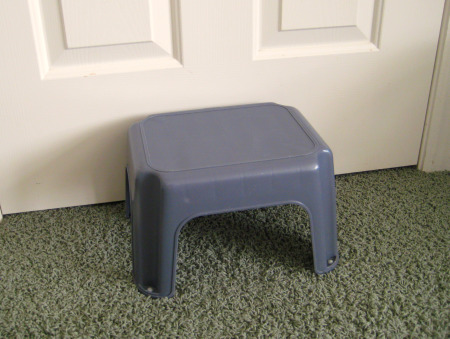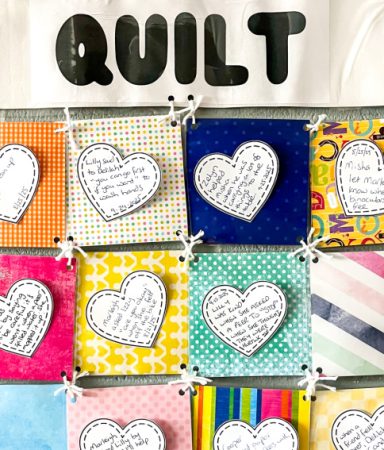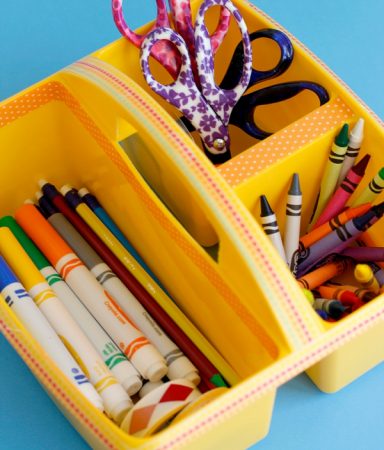We’re a family who has a “time out” stool in our home. It’s a place where we send our kids when they need a little time out. It might be time out from their siblings, friends, or an activity, most often times when they’ve done something bad. It helps them, and me, calm down. Here’s a few things I think are important to do if you choose to have time out for your children.
 1. Where is time out going to be? It’s important to establish a permanent place for time out. It could be on a chair or stool, in the hall or in the kitchen. I feel it’s better to keep it outside of the child’s room, so that they don’t fear or have bad feelings towards their room or bed. We use this gray stool and place it in the hall. It’s just something generic. It could be cute and crafty, but there’s not really anything cute and crafty about being in trouble or time out. It’s serious time, (mom means business) so I like it to be a place where they are away from any distractions.
1. Where is time out going to be? It’s important to establish a permanent place for time out. It could be on a chair or stool, in the hall or in the kitchen. I feel it’s better to keep it outside of the child’s room, so that they don’t fear or have bad feelings towards their room or bed. We use this gray stool and place it in the hall. It’s just something generic. It could be cute and crafty, but there’s not really anything cute and crafty about being in trouble or time out. It’s serious time, (mom means business) so I like it to be a place where they are away from any distractions.
2. Let them sit alone. Give them time to be there, even if it’s just 30 seconds for a small child. My 2 year old (yes, we put our 2 year old in time out) can be there for 20-30 seconds. She gets up sometimes, but we just put her back down. For my older children, we let them sit there for a couple of minutes (or longer if I forget, opps!) It’s as long as it takes for them to calm down from being mad or sad.
3. We talk about why they are there. Once they’ve calmed down, we just talk. I ask them why I put them in time out in the first place. Sometimes they don’t know, so I tell them. I think it’s important for children to know the reasons. In some situations, we talk about how they might feel if it was reversed. “How would you feel if Sarah hit you?” Or “Would you like it if Sarah took your toy?” This can help them see things in a different perspective and hopefully think twice about doing it again next time.
4. Saying more than just “I’m sorry”. I feel it’s important for our kids to say what they are sorry for. Here’s our dialogue: “I’m sorry” “You’re sorry for what?” “I’m sorry for _______”. I think this can put more meaning behind the apology.
5. Always end with a hug. After we’ve talked and they’ve apologized, to me and/or the offended, then we hug it out. It’s always good to have closure to an event, especially if it was traumatic, even semi-traumatic, and a hug always does the trick.
Having “time out” has been something good for our family. Our children have been able to put things into other people’s perspectives, as we’ve always talked about what they did and what they are sorry about. It doesn’t mean they are perfect, they still spend time on that stool, but they are able to go through this process with a little more understanding.








Love this post! I loved how you just talked about what works in YOUR family and didn’t impose your ideas on the rest of us. Thanx for your perspective.
With that being said, we do a “time-out” chair as well, but we call it the “Thinking Chair” so that the kids can sit and THINK about what they’ve done. Our process is almost identical to yours! (haha)
I agree about it being outside of their rooms. I want their rooms to be a positive place for them and not associated with negativity. Great point, in my opinion.
We also do as Sooz mentioned–they sit for as many minutes as they are old. We set a timer that dings at the end so that I don’t forget (’cause we all know how often THAT happens!).
Again, love this post! It was fun to read what others do in their homes, as well! Thanx!
my daughter’s 7th b-day is tomorrow. I have yet to figure out a way to Make her stay in the time-out space. her: “oh was I supposed to not move, Ididn’t know that” me:” stay in time out or its restrictions” half a second later her screams move down the hall “oh was I supposed to not move? …” etc. attention span less than gnat.
my step kids get the 4th step.. no matter where we are 4th step is where they sit for timeout. And they sit for as many minutes as they are old. So my 8 yr old stepdaughter sits for 8 minutes.. and her time dosent start until she is quiet. so if she’s up there crying, talking, screaming, wining whatever for a half an hour then she sits there 8 minutes after she stops the nonesence. It works wonders. there have been days when she is having a complete tantrum and crys on the steps for no reason for an hour then finaly is quiet and can get off 8 minutes later.. My stepson has the problem of forgetting the no talking rule.. so about three minutes in he askes to get up and his time has to start over. It works wonders because none of them want to sit there for that long, and it;s not comfortable, and they have to sit not lay on the steps. there are days when they have been there for so long that they fall asleep on the steps. lol
We always make sure that we can watch the kiddos, and they can see us. It helps us to see how they are processing the situation, and it shows them that even when they might need a little discipline, we want them with us, and that they are still welcome with whatever we are doing.
Erika – I love the addition of the recipient saying “I forgive you”. I’m going to have to add that in. What a great thing to learn at a young age.
Ruth – Yes, in fact, my daughter (and all my kids) were learning this process from 18 months. It’s pretty quick in TO, but it helps them start this routine to get better at it when they are older.
Adele – yay for your girl. How funny about your boys!
Suite – I can’t wait to chat and hear more about the “time in’s”. I’m sure it’s a great way to use positive words for their behaviors. Maybe I’ll have to have you share it here at M&T when you master it!
Thanks for all the feedback and conversation everyone!
What timing!
Danny and I have been having discussions about discipline for Holden. I want to have a philosophy and plan established before we really need to use it. :)
I just read on the Attachment Parent International Website about “time-in’s.” I think of it as the hippie-feel-good version of time-outs. I can’t wait to discuss this with you.
Great post. I completely agree, especially about the part where they say they’re sorry for… I think it is also very important to say “I forgive you.” So they know they have had their consequence and can now start fresh.
I agree, talking about why they were put in time out afterwards and encouraging them to hug or apologize to the offended party is so important. I’ve had them go to their rooms to cool off, or stand in the corner (facing away from all the fun!)
We have just started putting our 20 month-old twins in time out when they do something they know is wrong. They are there for just about 30 seconds but they get the point (well, my daughter “gets it” better than my son who thought it meant “alone time with Mummy” the first couple of times- now he’s better). I found that if you start early, you will avoid the battles to “stay” in the chair when they are older and more argumentative!
I’ve started sending my 2 1/2 yo to her room when she throw a fit – I say “go to your room” – and she does. And my boys (I have 5 of them who range from 17-9) look at her in amazement…one of them the other day said, “you just say that and she does it???” And I said, yup – take notes!! ;) Hopefully with this one will learn a few things ;)
My son is almost 20 months old. He has been really irritating me by throwing everything. He especially likes to throw things through the banister and down our hard word stairs. It makes me crazy but I feel it is still a little to early for disciplining. I might wait another couple months to start (if my stairs can wait that long) but I will give this a try. Thanks for including that (yes we put our two year old in time out) aside. It definitely makes me feel better about our discipline plan.
This is a great break-down of how to do what I’m really bad at: consistently work on the kids’ behavior. I’m definitely going to use this.
I’d like to add to the “Saying sorry” part. . . Some parenting mentors of ours suggested we have the kids actually ask for forgiveness as this 1) requires more humility, 2) requires the offended party to work out any anger he/she may be dealing with, and 3) brings definite closure to the whole ordeal when the offended says “Yes, I’ll forgive you.” They suggest we, adults, should do this, too.
Just an additional thought.